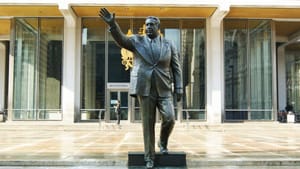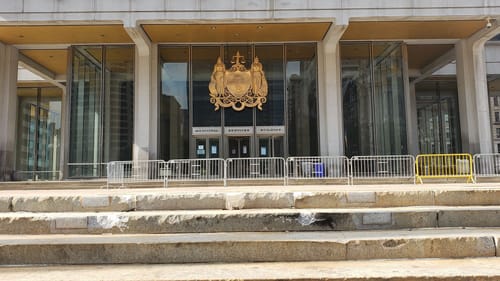Stay in the Loop
BSR publishes on a weekly schedule, with an email newsletter every Wednesday and Thursday morning. There’s no paywall, and subscribing is always free.
A real monument to the people
What’s next for the Frank Rizzo statue?

On June 3, 2020, the statue of late mayor Frank Rizzo was removed from the steps of the Municipal Services Building, and now the question remains: what will become of it? The 10-foot-tall bronze monument is a work of art and a testament to a complicated chapter in Philadelphia history; these considerations tip the statue’s future into the wheelhouse of the museum world, for preservation and interpretation.
A certain sense of history
The statue was unmistakable from its perch on top of the steps of the MSB—arm outstretched as if waving down a taxi. The pose was modeled from a photograph of the former mayor waving to a crowd during a St. Patrick’s Day parade. Commissioned shortly after Rizzo’s death, the monument was created by local artist Zenos Frudakis and cast in the Loran Bronze Foundry in Chester, Pennsylvania.
Speaking with BSR, Jody Della Barba, one of the members of the original commissioning committee, recalled that the original designs for the bronze sculpture captured the dynamism of the former mayor. Beneath the surface, however, the design also conveys a certain sense of history.
American bronze
In the United States, the medium of bronze ties back to the post-Revolution era, when national bronze foundries began to emerge alongside the country’s artistic independence and assertion of its own aesthetic self-sufficiency. No longer were European foundries and artists commissioned to create monuments and striking memorials in the ponderous medium; instead, American artists and foundries began to establish their own practice.
The number of foundries blossomed after the American Civil War, notes art historian Thayer Tolles, as 1865 through 1918 represented a golden age of American bronze sculpture: “The Civil War created a demand in both the North and South for public sculpture commemorating military heroism and sacrifice, from common soldier to admiral to general … Most of these monuments were produced in bronze, in a Beaux-Arts aesthetic that emphasized naturalism and dynamic treatment of form and surface.”
In comparison to the formerly favored medium of marble, bronze was viewed as stronger and more august, and the capacity to produce such monuments—and to display them in public spaces—was a clear indicator of a city’s power. Cities like New York, Washington, DC, and of course Philadelphia led the way.
Toppling statues
So it’s no wonder that as the United States today questions how civic power is exercised, and by whom, many bronze statues have come down. But part of the aesthetic power of bronze lies in its weight, in the force of its presence, and the resulting difficulty of toppling it.
For Frank Rizzo’s monument, the power and authority the city exercised when it installed the donated statue on the final day of 1998 required an equal strength remove it on June 3. Protesters noted this while attempting to remove the piece from public display.
“Violent attempts to dislodge the 3000-pound bronze statue greatly alarmed me due to danger of it falling and crushing those around it,” Frudakis himself said on Facebook at the time. “There was also the possibility of it breaking through the pavement and falling into the subway concourse immediately beneath it, taking with it those nearby.”

Whose responsibility?
As Gail Obrender recently noted in BSR, “Along with the shifts in interpretation due to societal and cultural changes, the physicality of artworks is always a challenge,” and the sculpture’s physicality is just one factor that its future home will have to take into account. The statue’s fate will largely depend on the outcome of a pending lawsuit of the Frank L. Rizzo Monument Committee to regain possession of the statue from the city; failing this, it becomes the city’s responsibility to propose a new site to the Philadelphia Art Commission.
“I can't predict how [the Art Commission] might respond to a proposal that is hypothetical,” said Philadelphia Department of Planning and Development spokesperson Paul Chrystie. “In addition, the Art Commission is not involved in the development of the proposals that come before it. That responsibility lies with the owner of the art.”
When contacted by BSR about the statue’s possible future, the Pennsylvania History Museum, Woodmere Art Museum, and the Philadelphia Museum of Art did not respond to a request for comment, and the African American Museum in Philadelphia politely declined to comment.
What’s next?
As Rizzo waits, Philadelphia prepares to decide the fate of another statue that became the site of powerful protests this year: the figure of Christopher Columbus (now covered by a wooden box) in South Philly’s Marconi Plaza. A public meeting to discuss that statue’s fate will be held virtually and via telephone on July 22 at 9:30am.
For now, Rizzo’s bronze likeness remains in storage at an undisclosed location, out of sight but not out of mind. Ultimately, it was the weighty solidity of the bronze that drew out the strength of the protest and the tools of the city required to move it. Even if not in the way the original committee may have expected, the Rizzo statue became a monument to the people—in its absence. Philadelphia will be watching for its next move.
Sign up for our newsletter
All of the week's new articles, all in one place. Sign up for the free weekly BSR newsletters, and don't miss a conversation.

 Helen Walsh
Helen Walsh